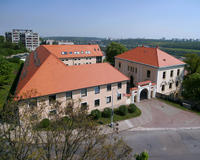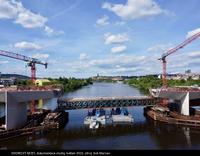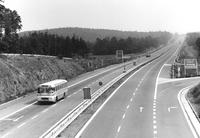Pragoprojekt was established in 1969 in the process of Czechoslovak federalisation by the separation of the Prague office of Dopravoprojekt which had its headquarters in Bratislava. Yet its real roots can be tracked back even 20 years earlier, when the first specialised studio of traffic construction was founded in the then Stavoprojekt company. At the early stages the company acquired a group of commercially, technically and conceptually skilled professionals, who thanks to their progressive minds laid a firm foundation to a robust and first-class design and engineering company, able to use a comprehensive approach to deal with traffic construction issues.
From the very beginning, Pragoprojekt specialized in the design of traffic infrastructure, in related consultancy and in surveys focussed at the preparation of motorway and road projects. Soon after the company was founded, a studio of structural engineering was established and in future years the portfolio expanded by solutions for the introduction of urban public transport systems (trams, buses), building constructions diagnostics, by the then new environmental protection solutions, engineering activities and the development of in-house software system for the design of motorways and road projects including programs for the computations of bridges.
Pragoprojekt from the beginning operated both in the whole territory of then Czechoslovakia, as well as abroad. If we look ata road and motorway map of today's Czech Republic, there is no motorway or road whose construction or reconstruction would not be prepared by Pragoprojekt or in which Pragoprojekt would not be involved at some stage of preparation. A number of important – and not only traffic – projects were successfully realized just according to designs that originated on the desks or screens of Pragoprojekt designers. They include studies and designs of motorways, projects of the general road network, of by-passes and town through-flows, bridges and tunnels, trolleybus and tram systems and routes, traffic works, new buildings and reconstructions, fuel stations, city and municipality planning schemes, traffic surveys, designs of road junctions and traffic at rest, to name just a few.
During its tenure, the company's management took a number of strategic decisions that significantly contributed to achieving its current status and market position. One of them is undoubtedly the focus on work abroad, where dozens of experts were sent – particularly in the 1970's – who were involved in the preparation, management and realization of complex traffic projects. The Middle East was then the main area of interest, however a number of contracts was also realized in other European countries or in Asia. Besides the involvement of company's numerous experts in bridge and road construction in Iraq, other activities in Afghanistan, Iran, Algeria, Syria, Laos are worth mentioning and last but not least the activities connected with the preparation of a motorway following the route of the Silk Road across the territory of Uzbekistan.
The subsequent strategic step was also building and opening of a new company headquarters in Prague, a refurbished former vine farmstead called Ryšánka, including its for then period state-of-the-art equipment.
 Who we are
Who we are
 Vision and Mission
Vision and Mission
 Company history
Company history
 Organizational structure
Organizational structure
 Certification
Certification
 Code of ethics
Code of ethics
 Awards
Awards
 Equipment
Equipment